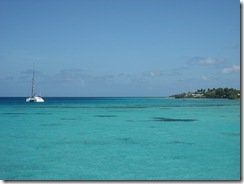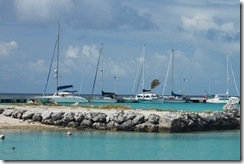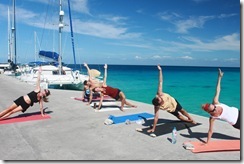Okay. Refocus. Rethink my objective. Take a deep breath. And go through the piles again.
Such is the ritual of purchasing black pearls in the Tuamotus in French Polynesia, a paradise group of islands in the middle of the South Pacific. And it's a darn good time. Especially when you can walk away with some great finds.
French Polynesia's black pearl market got underway in the 1960's and has seen its ups and downs. At one time, there were dozens of pearl farms on almost every inhabited atoll of the Tuamotus, but at some point the market got so saturated that the price of pearls plummeted. The result is that there are now only a few family-run operations while some of the larger foreign corporate businesses have taken over much of the industry. We visited Dream Pearls, a larger family farm on Fakarava, just outside the town of Rotoava, run by Lulu Steiner. Lulu is a German Swiss man who came to French Polynesia 25 years ago where he met and married his beautiful wife Mimi, who runs the jewelry shop in town near the harbor.
The four year process of creating these beautiful cultured gems is absolutely fascinating. It begins on some of the smaller atolls where divers find baby oysters and sell them to the farms for 1 Euro each. Lulu's operation purchases 25,000 oysters every month. When these oysters get big enough, they are brought into the grafting houses, which are essentially wooden shacks on stilts just above the aqua colored lagoon's edge to ensure that the shells will spend as little time as possible out of water. Here, the shells are pried open. A nucleus (which resembles a white ball) together with a tiny piece of mantle tissue (the organ which secretes mother of pearl) from an oyster shell found in the Mississippi of all places, are then inserted inside the host oyster shell. The mantle tissue initiates the grafting process so that the oyster can now secrete the colored mother of pearl around the nucleus. The host oyster is made to believe that these organic matters are its own and continues to grow the pearl inside it for another 18 months. To complicate matters, the shells must be cleaned and disinfected every 4 months in a huge machine that looks like a commercial dish washer to keep parasites and bacteria at bay. This means that on a rotating basis, Lulu's staff cleans over 400,000 shells each each year, four times over the life of the oyster shell while growing its pearl. Pearls can grow on average up to 11 mm in size during this initial process.
More and more, however, there has been a demand for larger pearls. And so the process continues, with expert grafters sitting in grafting houses for hours each day removing the original pearl for inspection. If the pearl is near perfect, and because the pearl can only grow to be as big as the oyster's nucleus, it will get put back into the oyster with a new larger nucleus for a second and sometimes a third graft. This was the process we witnessed. As the grafter pried open the shell, she inserts her long silver tool resembling what a dentist uses to test your teeth for cavities. When she pulls out what appeared to be a perfectly shaped round lustrous black pearl, I couldn't help but feel that I was witnessing a birth. And yet most of these gems went into the bowl that meant it was not perfect enough for a second graft. During the half hour of our observation, I saw only two pearls being reinserted for a subsequent graft.
There is a notion that larger black pearls, which have been grafted two or three times, may not be as organically sound since the layers may crack with changes of temperature. Lulu assured us, however, that at his farm, only the very best pearls get grafted more than once and thus are much more valuable. There is no doubt that Lulu takes great pride in his operation, and you couldn't help but feel his pearls were, in fact, top quality.
So when we arrived in his showroom, we all went nuts over the pearls he was selling for 80,000 French Polynesian Francs - the equivalent of $10,000. He also had on display an 18 mm pearl that was too rare to be for sale, and I'll admit it was a big honking gem. Nonetheless, it would have paled in comparison to the largest recorded black pearl, at 26 mm.
Lulu's prices, which he reminded us several times were showroom prices and much less than in the jewelry shops, ranged from small 6 mm ones for 3000 Francs (about $35) up to 80,000 Francs. Then there were magnificent necklaces for thousands of dollars more. 'Nuff said. It was all so professional and civilized - and out of our price range.
This whole experience was in sharp contrast to our visit to the largest house on Makemo Atoll, an orange two-story that stood out in this small village in sharp contrast to the mostly shacks and one room cement brick homes. There we were seated at a table with boxes and boxes of pearls of all shapes and sizes and colors - and we had to fend for ourselves. The prices there were much more clearly in our price ranges, and we were able to find pearls ranging in prices that went as low as 2500 Francs (about $30) for an 11 mm pearl (compared to Lulu's $100 for the same size). Unfortunately for us, we didn't realize how good Makemo's prices were at the time for what seems to have been equivalent quality, since our visit to Dream Pearls on Fakarava came only later. We still managed to drop a good amount of change on Makemo nonetheless - cash only as one should expect in all the off-the-beaten-path atolls where most visitors come by boat and the clientele tend to be local Polynesians. In contrast, on the more touristed atolls like Fakarava, many shops and farms accept credit cards.
Like diamonds, black pearls are graded based on several categories, such as luster or sheen (the best ones should reflect the light creating a mirror-like effect), size (obviously the larger ones are more valuable), and surface smoothness (any punctures, deposits, streaks or swellings on the surface are considered imperfections). In theory, each of these criterion can be tested by simply having a look. And based on these criteria, the pearls are graded A,B,C or D quality. Anything less than D quality are not supposed to be sold, although we found that at least a couple of the smaller shops (as well as the pearl farm we visited in Makemo) did sell these lower quality pearls at heavily discounted prices. You just have to ask for them. Our friend Diane was practically gifted several dozen of these pearls on Nuku Hiva for $1 a piece, but our experience found the lowest prices on Fakarava to be $3. Good for Danielle's beading hobby.
Beyond the above criteria, there are two more things to look for, simply based on pure preference and not affecting the quality categories. The first is color which ranges in hues and tints of reds, pinks, purples, greys, blacks, silvers, greens, blues, and champagnes. I fell in love with the green ones but it really is a personal preference. In addition, the pearls come in many shapes aside from the traditional round. We actually found the dew drops, the baroques (odd shaped) and ringed ones to be most interesting, and we of course opted mostly for these in our own purchases, with a few rounds thrown in for good measure.
I would be remiss if I recounted our tale of buying black pearls without the mention of the weight of my purse as we did so. In it I lugged a bottle of rum, some perfume and some face cream, all with the hopes of trading for pearls like our cruising guidebooks advised. No such luck - we were laughed at the first couple of times that we pulled out the items, so that by the third time I didn't even bother. It was too embarrassing. The black pearl market seems much more sophisticated than legend foretold, although with enough quantity in your check-out basket, you can still bargain down the prices in some places. The best we did was a 20% discount.
Sure we left each pearl farm and shop a bit more cross-eyed than the last. But once back at the boat, and after closely examining and comparing the purchases from our various sources, we found the trees. Or the forest. Or whatever it was we were supposed to find. In other words: We found delight and contentment in our purchases, our knowledge and understanding of a complex but graceful and beautiful process, and of another fulfilling traveler's adventure.
-Barb
En route from the Tuamotus to Tahiti, French Polynesia
P.S. Pictures must follow when we get internet.
-----
At 6/24/2011 05:31 (utc) our position was 17°27.08'S 149°18.88'W



